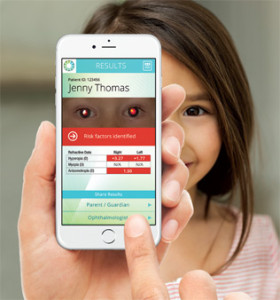This past month we introduced an exciting new technology at purePEDIATRICS, GoCheck Kids™. This is the first smartphone application in the world designed for pediatric vision photo screening. With the simple click of a smartphone camera, the GoCheck Kids app can determine if your child is at risk for amblyopia (or “lazy eye”), which is the #1 leading cause of permanent vision loss.
The GoCheck Kids™ photoscreening app is designed to screen children for amblyopia as early as 6 months of age, and studies show that 15-20% of children are at risk. For this reason, we would like to detect problems as early as possible to prevent vision loss.
Because the photoscreening is done using a smartphone, it is as simple as taking a picture. Therefore, it is not scary at all to kids – a huge priority for us at purePEDIATRICS. Since implementing the GoCheck Kids™ photoscreening app in the office, we have successfully screened many children and made timely referrals to eye specialists.
Screening is recommended yearly and can be done at the annual evaluation. At this time, both the American Academy of Pediatrics and the American Association for Pediatric Ophthalmology & Strabismus recommend photoscreening.
We are excited to offer this new screening for our patients. If you would like to learn more, please ask us or visit GoCheck Kids™ at their website.
Here are some answers to questions you may have:
Why are we offering photo screening with GoCheck Kids™?
To screen for amblyopia, the #1 cause of vision loss in children
- Catches potential vision problems early
- Recommended by the American Academy of Pediatrics
What is amblyopia?
Amblyopia, or “lazy eye,” is a condition that can develop when one eye has poor vision. The brain favors the “good” eye and ignores the images coming from the eye with poor vision. This prevents the vision from fully developing and can cause permanent vision loss in the affected eye. When this happens, even glasses cannot help.
What are the risk factors for amblyopia?
- Nearsightedness (myopia) – child can see up close but not far away
- Farsightedness (hyperopia) – child can see far away but not up close
- Unequal prescriptions (anisometropia) – vision in each eye is different
How does GoCheck Kids™ work?
- Takes a single photo of just the eyes
- Identifies “crescents” within the red reflex that can indicate a refractive risk
- Crescent size and location determine the type and amount of disorder
- Crescents are measured in diopters, which indicated the optical power of a lens that is needed to correct vision to normal (20/20)
How much does the photo screening cost?
The screening costs $30 and it may be reimbursable by your child’s insurance.
Doesn’t an eye chart work just as well?
No. Photoscreening can detect certain vision problems that cannot always be detected using an eye chart and can be used in children who are not yet ready to read a wall chart or who are unable to cooperate.






Find us in: